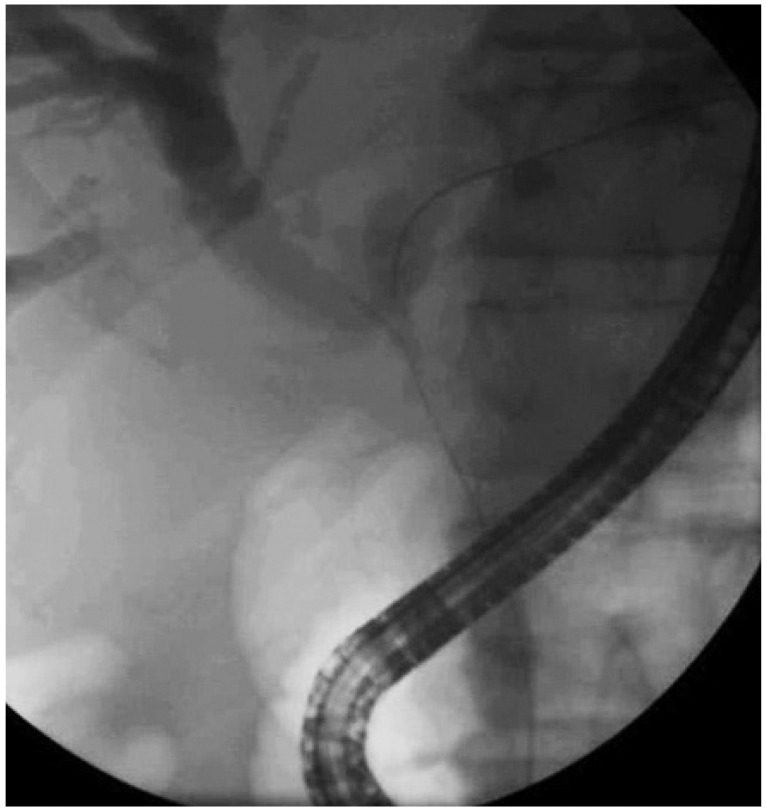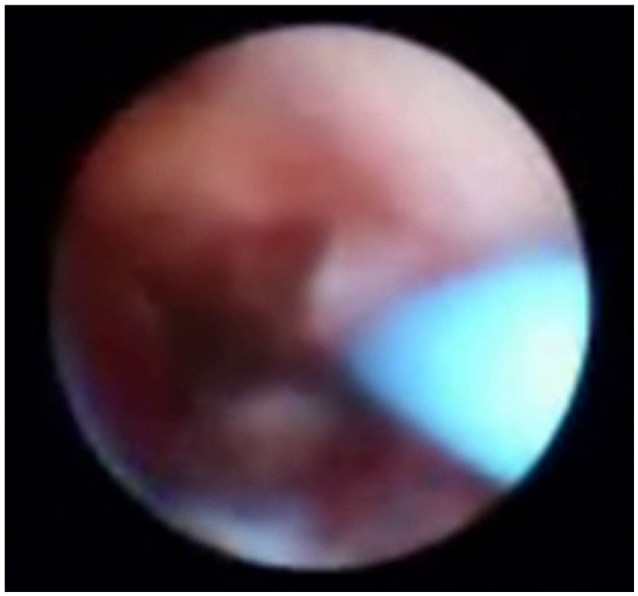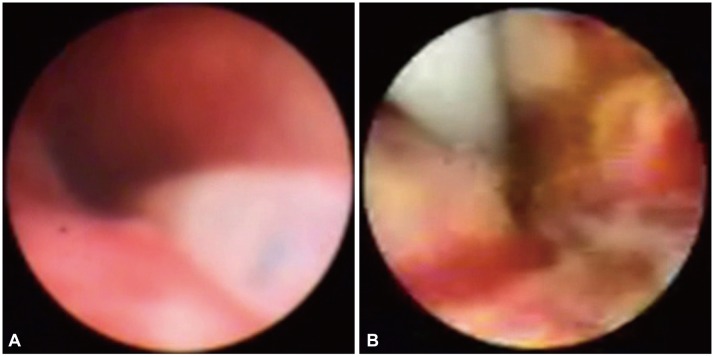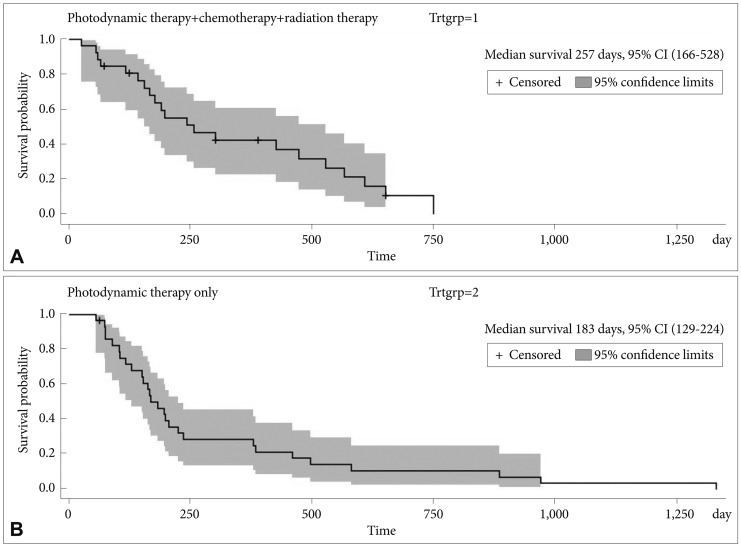Clin Endosc.
2013 Jul;46(4):390-394.
Photodynamic Therapy in Unresectable Cholangiocarcinoma: Not for the Uncommitted
- Affiliations
-
- 1Department of Gastroenterology and Hepatology, University of Virginia School of Medicine, Charlottesville, VA, USA.
- 2Division of Gastroenterology and Hepatology, Department of Medicine, Weill Cornell Medical College, New York, NY, USA. mkahaleh@gmail.com
Abstract
- BACKGROUND/AIMS
Photodynamic therapy (PDT) in unresectable cholangiocarcinoma has been associated with improved survival. We report a single tertiary care center experience over the past 6 years.
METHODS
Fifty-five patients with unresectable cholangiocarcinoma received PDT between 2004 and 2010. Plastic stents were placed after PDT to prevent cholangitis.
RESULTS
Twenty-seven patients (49%) showed Bismuth type IV, 22 (41%) showed Bismuth type III, and six (10%) showed Bismuth type I and II. Twenty patients (37%) received chemotherapy and radiation therapy, five (9%) received chemotherapy only; and one (2%) received radiation therapy only. Mean number of PDT sessions was 1.9+/-1.5 sessions (range, 1 to 9). Mean survival duration was 293+/-266 days (median, 190; range, 25 to 1,332). PDT related complications included three (5%) facial burn, three (5%) photosensitivity, and two (3%) rash. Kaplan-Meier analysis comparing the survival means of patients who received PDT and chemotherapy/radiation therapy (median survival 257 days; 95% confidence interval [CI], 166 to 528) versus who received PDT only (median survival 183 days; 95% CI, 129 to 224) showed no significant difference (log-rank p=0.20).
CONCLUSIONS
PDT has a measurable impact on survival in unresectable cholangiocarcinoma but requires aggressive stenting posttherapy.
MeSH Terms
Figure
Reference
-
1. Anderson CD, Pinson CW, Berlin J, Chari RS. Diagnosis and treatment of cholangiocarcinoma. Oncologist. 2004; 9:43–57. PMID: 14755014.
Article2. Gao F, Bai Y, Ma SR, Liu F, Li ZS. Systematic review: photodynamic therapy for unresectable cholangiocarcinoma. J Hepatobiliary Pancreat Sci. 2010; 17:125–131. PMID: 19455276.
Article3. Wiedmann M, Berr F, Schiefke I, et al. Photodynamic therapy in patients with non-resectable hilar cholangiocarcinoma: 5-year follow-up of a prospective phase II study. Gastrointest Endosc. 2004; 60:68–75. PMID: 15229428.
Article4. Zoepf T. Photodynamic therapy of cholangiocarcinoma. HPB (Oxford). 2008; 10:161–163. PMID: 18773045.
Article5. Judah JR, Draganov PV. Intraductal biliary and pancreatic endoscopy: an expanding scope of possibility. World J Gastroenterol. 2008; 14:3129–3136. PMID: 18506916.
Article6. Fishman DS, Tarnasky PR, Patel SN, Raijman I. Management of pancreaticobiliary disease using a new intra-ductal endoscope: the Texas experience. World J Gastroenterol. 2009; 15:1353–1358. PMID: 19294765.
Article7. Cheon YK. The role of photodynamic therapy for hilar cholangiocarcinoma. Korean J Intern Med. 2010; 25:345–352. PMID: 21179270.
Article8. Zoepf T, Jakobs R, Arnold JC, Apel D, Riemann JF. Palliation of nonresectable bile duct cancer: improved survival after photodynamic therapy. Am J Gastroenterol. 2005; 100:2426–2430. PMID: 16279895.
Article9. Ortner ME, Caca K, Berr F, et al. Successful photodynamic therapy for nonresectable cholangiocarcinoma: a randomized prospective study. Gastroenterology. 2003; 125:1355–1363. PMID: 14598251.
Article10. Kahaleh M, Mishra R, Shami VM, et al. Unresectable cholangiocarcinoma: comparison of survival in biliary stenting alone versus stenting with photodynamic therapy. Clin Gastroenterol Hepatol. 2008; 6:290–297. PMID: 18255347.
Article11. Harewood GC, Baron TH, Rumalla A, et al. Pilot study to assess patient outcomes following endoscopic application of photodynamic therapy for advanced cholangiocarcinoma. J Gastroenterol Hepatol. 2005; 20:415–420. PMID: 15740486.
Article12. Fuks D, Bartoli E, Delcenserie R, et al. Biliary drainage, photodynamic therapy and chemotherapy for unresectable cholangiocarcinoma with jaundice. J Gastroenterol Hepatol. 2009; 24:1745–1752. PMID: 19780885.
Article13. Quyn AJ, Ziyaie D, Polignano FM, Tait IS. Photodynamic therapy is associated with an improvement in survival in patients with irresectable hilar cholangiocarcinoma. HPB (Oxford). 2009; 11:570–577. PMID: 20495709.
Article14. Matull WR, Dhar DK, Ayaru L, et al. R0 but not R1/R2 resection is associated with better survival than palliative photodynamic therapy in biliary tract cancer. Liver Int. 2011; 31:99–107. PMID: 20846273.
Article15. Talreja JP, Degaetani M, Sauer BG, Kahaleh M. Photodynamic therapy for unresectable cholangiocarcinoma: contribution of single operator cholangioscopy for targeted treatment. Photochem Photobiol Sci. 2011; 10:1233–1238. PMID: 21512706.
Article16. Choi HJ, Moon JH, Ko BM, et al. Clinical feasibility of direct peroral cholangioscopy-guided photodynamic therapy for inoperable cholangiocarcinoma performed by using an ultra-slim upper endoscope (with videos). Gastrointest Endosc. 2011; 73:808–813. PMID: 21316667.
Article17. Witzigmann H, Berr F, Ringel U, et al. Surgical and palliative management and outcome in 184 patients with hilar cholangiocarcinoma: palliative photodynamic therapy plus stenting is comparable to r1/r2 resection. Ann Surg. 2006; 244:230–239. PMID: 16858185.18. Guglielmi A, Ruzzenente A, Iacono C. Surgical Treatment of Hilar and Intrahepatic Cholangiocarcinoma. Verona (IT): Springer;2008.
- Full Text Links
- Actions
-
Cited
- CITED
-
- Close
- Share
- Similar articles
-
- Photodynamic Therapy for Unresectable Cholangiocarcinoma:Does It Really Increase the Survival Time?
- Photodynamic Therapy for Cholangiocarcinoma
- Comparing palliative treatment options for cholangiocarcinoma: photodynamic therapy vs. radiofrequency ablation
- Current treatment outcome of hilar cholangiocarcinoma
- Photodynamic Therapy for Hilar Bile Duct Cancer





